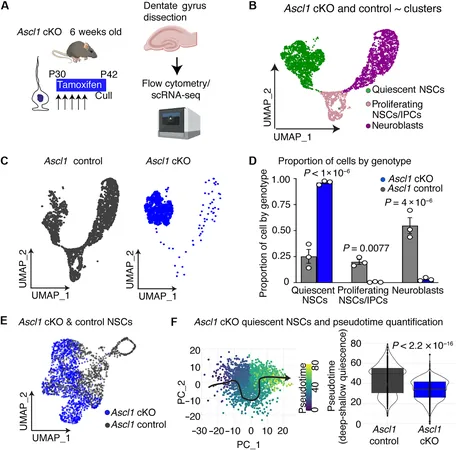
Unlocking the Secrets of Brain Stem Cells: A Game-Changer for Cancer and Degenerative Diseases!
2025-07-14
Author: Ming
A Groundbreaking Discovery in Brain Research
In an extraordinary breakthrough, researchers from QIMR Berghofer and the Francis Crick Institute have unveiled the enigmatic mechanisms behind brain stem cells and their ability to enter a dormant state known as "quiescence." This remarkable finding, revealed in the latest issue of Science Advances, could pave the way for revolutionary treatments in brain health and cancer therapy.
The Lifelong Potential of Brain Stem Cells
For years, it was thought that the neurons we acquire at birth are the only ones we'll ever have. However, emerging studies have shown that a small population of stem cells within the adult brain continuously produces new nerve cells, playing a pivotal role in our memory and cognitive functions.
The Mystery of Quiescence: Nature’s Ancient Strategy
These brain stem cells often exist in a hibernation-like state, significantly reducing their metabolic activity to conserve themselves for critical moments. This quiescent state isn’t exclusive to the brain; it’s an ancient biological mechanism seen across various species—from yeast to humans and in different tissues like muscle and blood.
Mapping the Sleep Cycle of Brain Stem Cells
What makes this research truly groundbreaking is the revelation of how brain stem cells transition between varying levels of rest, akin to shifting from deep sleep to light sleep. For the first time, scientists have delineated the process by which these cells oscillate between different states—a discovery that not only highlights the brain's regenerative capabilities but also primes it for recovery amid injury or illness.
A Game-Changer for Treating Brain Cancer
Dr. Lachlan Harris, the senior author of the study, emphasizes the significance of this research, stating, "Understanding this process is crucial for self-repair in the brain, especially against neurodegenerative disorders—but it also has significant implications for brain cancer. Tumor cells exploit this ancient quiescent mechanism to dodge treatments such as chemotherapy and radiotherapy.”
The Dormant Time Bomb of Brain Tumors
Aggressive brain tumors, like glioblastoma, are notoriously challenging to treat because certain cancer cells can slip into this dormant state, evading conventional therapies designed to attack active cancer cells. These hidden "sleeping" cells may survive initial treatments, only to awaken later, fueling tumor recurrence—a major reason brain cancers often return with a vengeance.
New Therapeutic Strategies on the Horizon
The tireless efforts of the QIMR Berghofer and Crick teams have opened the door to innovative treatment strategies. By learning how to manipulate the resting states of healthy brain stem cells, scientists aspire to awaken dormant cancer cells for targeted therapy or maintain them in slumber indefinitely to stave off tumor regrowth.
A Transformative Step Forward in Medicine
Dr. Harris encapsulates the significance of their discovery: "This foundational knowledge doesn’t merely advance our understanding of brain biology; it charts new territories for developing transformative treatments for brain cancer and other neurological diseases." This ancient biological process holds newfound promise for tackling some of the toughest challenges in modern medicine, and researchers are eager to unleash its potential for future brain health solutions.


 Brasil (PT)
Brasil (PT)
 Canada (EN)
Canada (EN)
 Chile (ES)
Chile (ES)
 Česko (CS)
Česko (CS)
 대한민국 (KO)
대한민국 (KO)
 España (ES)
España (ES)
 France (FR)
France (FR)
 Hong Kong (EN)
Hong Kong (EN)
 Italia (IT)
Italia (IT)
 日本 (JA)
日本 (JA)
 Magyarország (HU)
Magyarország (HU)
 Norge (NO)
Norge (NO)
 Polska (PL)
Polska (PL)
 Schweiz (DE)
Schweiz (DE)
 Singapore (EN)
Singapore (EN)
 Sverige (SV)
Sverige (SV)
 Suomi (FI)
Suomi (FI)
 Türkiye (TR)
Türkiye (TR)
 الإمارات العربية المتحدة (AR)
الإمارات العربية المتحدة (AR)